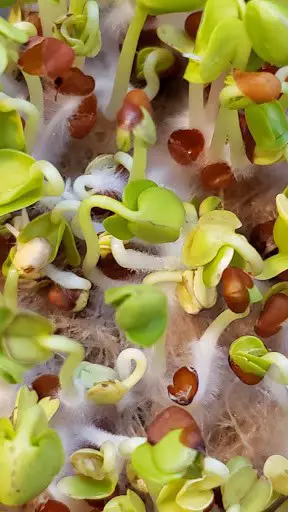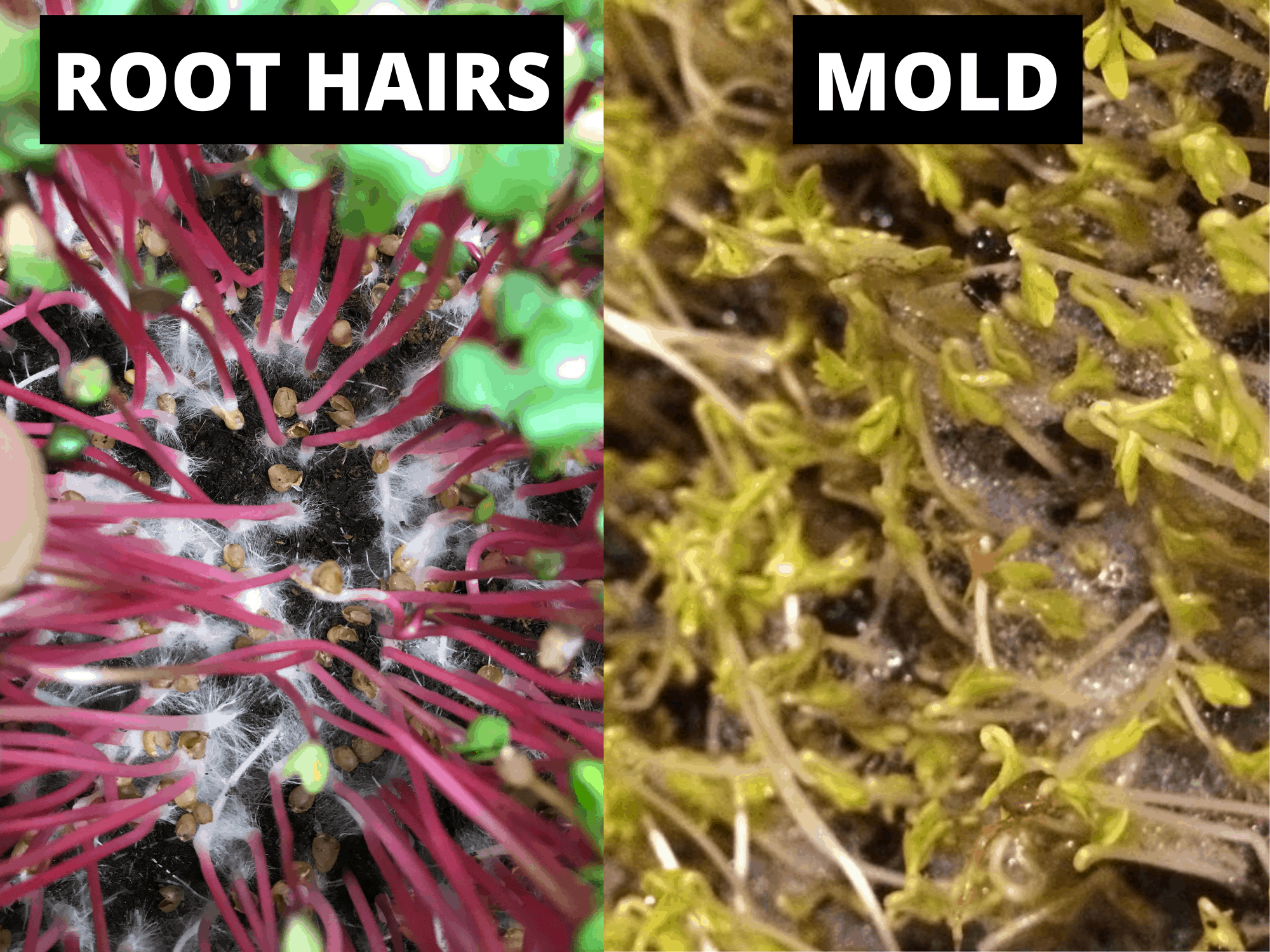When I grew my first microgreen tray, I was fascinated with how fast the greens grew. I would check my microgreen tray every day and see noticeable growth. One morning I was checking my microgreen tray and noticed that white hairs were growing out of the stems of my microgreens. Of course, my first thought was mold – so frustrating! So I did what any millennial does when they have a technical problem, I did some online research. After a few minutes of searching, I was relieved to learn that the white hairs were actually root hairs. So how do you know if your microgreens have a mold problem or are just growing root hairs?
While root hairs have a fuzzy appearance, mold has a cobweb-like appearance. Root hairs tend to cover the whole tray while mold can grow in patches. If you are unsure whether your microgreen tray has a mold problem, gently spray a portion of the white substance with water. Root hairs will disappear and mold will not.
The rest of this blog post will discuss root hairs in further detail and will outline ways to prevent mold problems.
What Are Root Hairs?
Root hairs are comprised of epidermal cells and are important in acquiring nutrients and water. When a new root hair cell grows, it excretes a poison so that the other cells in close proximity to it are unable to grow one of these hairs. This results in an even distribution of root hairs. Root hairs are a natural part of plant growth and are no reason for concern.

How Does Mold Affect Microgreens
Mold stunts microgreen growth and can eventually kill them. In most cases, mold is associated with a condition called damping off. Daming off is a horticultural disease associated with soggy or damp soil. The damp conditions promote fungal diseases. Symptoms of damping off are as follows:
- Stems may be water-soaked, soft, mushy, and may be discolored gray to brown;
- Roots may be absent, stunted, or have grayish-brown sunken spots; and,
- Presence of white cobweb-like growth.
How To Prevent Mold From Growing On Microgreens
As previously discussed, mold is often associated with damping off which adversely impacts microgreen growth. To prevent damping off, take the following preventative measures.
Bottom Watering Your Microgreens
Bottom watering is a technique that minimizes the chance of damping off because it forces the roots to reach for moisture and ensures that the growing medium is being watered evenly. To bottom water a tray of microgreens growing hydroponically, simply lift up the growing mat and apply water.
To bottom water a tray of microgreens growing in soil, use the double tray method. This involves planting your microgreens in a tray with drainage holes and placing the microgreen tray in another tray (without holes) full of water. The roots will extract water as needed.
Improve Drainage
Mold grows in damp conditions. For this reason, improving drainage significantly minimizes the chance of mold growth. If you are growing microgreens in soil, make sure your growing tray contains drainage holes. This will prevent overwatering.
Avoid Overseeding Microgreens
To minimize the chance of damping off, avoid overseeding. Overseeding can promote mold growth because an overly dense canopy of microgreens decreases the amount of air circulation.
Importance Of Air Circulation For Microgreens
Air circulation is another important aspect of preventing mold growth. Many microgreen growers will use fans to improve air circulation. If you are growing many trays of microgreens, it is important to note that fans can cause mold spores to travel among trays.
Sanitize Your Seeds And Equipment
Sanitizing your seeds and equipment with a hydrogen peroxide solution will ensure that you are not using materials that may contaminate your microgreens.
Can You Get Rid Of Mold Growing On Microgreens?
All microgreen growers will face mold problems at some point – even if they have taken all of the preventative measures listed above. Fortunately, there are some things you can do to get rid of mold growing on microgreens.
Mix A Hydrogen Peroxide Solution
To combat mold issues, mix equal parts water and 3% food-grade hydrogen peroxide and fill a spray bottle with the mixture. Spray your microgreens with the mixture to kill the mold.
Grapefruit Extract
Grapefruit extract is another alternative to hydrogen peroxide solution. Simply fill a spray bottle with ten drops of grapefruit extract per cup of water. Shake the bottle and thoroughly spray your microgreens with the solution.
Place The Microgreens In Direct Sunlight
Another way to kill mold is to place your microgreens in direct sunlight for a few days. Mold grows best in dark, damp conditions and does not like sunlight. It is important to note that your microgreens will need more water when they are placed in direct sunlight. For this reason, it is important to check your microgreens frequently and water them as necessary.
Remove Moldy Patches From Microgreen Tray
If only a small patch of microgreens have been infected with mold, it might be best to simply remove the moldy patch to prevent mold from spreading to the other plants.
Bonus Tip For Preventing Mold Growing On Microgreens
Do not try to rub the mold off of the microgreen stems. They are delicate and damaging the root hairs could kill the microgreens.
Is It Safe To Eat Microgreen Trays That Have Been Infected With Mold?
You definitely cannot sell a microgreen tray that is infected with mold, and you should never eat microgreens that are covered in mold! Some types of mold cause allergic reactions and respiratory problems. In the right conditions, a few types of mold can even produce poisonous substances called mycotoxins.
If only a portion of your microgreen tray has mold, you may be able to salvage some of your microgreens (for personal use) depending on the extent of the mold. Some microgreen growers will simply discard moldy patches of microgreens and continue to grow the rest of the tray. If more than 1/3 of your microgreen tray is covered with mold, it is probably best to discard the whole thing.
Always disinfect growing trays that have had mold problems. Spores can adversely impact the next batch of microgreens. To disinfect a growing tray, use warm, soapy water and food-grade hydrogen peroxide.

